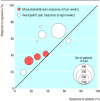Systematic review of topical capsaicin for the treatment of chronic pain
- PMID: 15033881
- PMCID: PMC404499
- DOI: 10.1136/bmj.38042.506748.EE
Systematic review of topical capsaicin for the treatment of chronic pain
Abstract
Objective: To determine the efficacy and safety of topically applied capsaicin for chronic pain from neuropathic or musculoskeletal disorders.
Data sources: Cochrane Library, Medline, Embase, PubMed, an in-house database, and contact with manufacturers of topical capsaicin.
Study selection: Randomised controlled trials comparing topically applied capsaicin with placebo or another treatment in adults with chronic pain.
Data extraction: Primary outcome was dichotomous information for the number of patients with about a 50% reduction in pain. Outcomes were extracted at four weeks for musculoskeletal conditions and eight weeks for neuropathic conditions. Secondary outcomes were adverse events and withdrawals due to adverse events.
Data synthesis: Six double blind placebo controlled trials (656 patients) were pooled for analysis of neuropathic conditions. The relative benefit from topical capsaicin 0.075% compared with placebo was 1.4 (95% confidence interval 1.2 to 1.7) and the number needed to treat was 5.7 (4.0 to 10.0). Three double blind placebo controlled trials (368 patients) were pooled for analysis of musculoskeletal conditions. The relative benefit from topical capsaicin 0.025% or plaster compared with placebo was 1.5 (1.1 to 2.0) and the number needed to treat was 8.1 (4.6 to 34). Around one third of patients experienced local adverse events with capsaicin, which would not have been the case with placebo.
Conclusions: Although topically applied capsaicin has moderate to poor efficacy in the treatment of chronic musculoskeletal or neuropathic pain, it may be useful as an adjunct or sole therapy for a small number of patients who are unresponsive to, or intolerant of, other treatments.
Figures
Comment in
-
It's not just about rubbing--topical capsaicin and topical salicylates may be useful as adjuvants to conventional pain treatment.BMJ. 2004 Apr 24;328(7446):998. doi: 10.1136/bmj.328.7446.998. BMJ. 2004. PMID: 15105325 Free PMC article. No abstract available.
References
-
- Nolano M, Simone DA, Wendelschafer-Crabb G, Johnson T, Hazen E, Kennedy WR. Topical capsaicin in humans: parallel loss of epidermal nerve fibres and pain sensation. Pain 1999;81: 135-45. - PubMed
-
- Reynolds JEF ed. Martindale: the extra pharmacopoeia. 32nd edn. London: Royal Pharmaceutical Society, 1999.
-
- British Medical Association. Royal Pharmaceutical Society of Great Britain. British national formulary. London: BMA, RPS, 2003. (No 45.)
-
- Prescription cost analysis. England 2002. Department of Health, London. 2003 ISBN 1 84182 710 X. www.doh.gov.uk/prescriptionstatistics/index.htm
-
- Rains C, Bryson HM. Topical capsaicin. A review of its pharmacological properties and therapeutic potential in post-herpetic neuralgia, diabetic neuropathy and osteoarthritis. Drugs Aging 1995;7: 317-28. - PubMed
Publication types
MeSH terms
Substances
LinkOut - more resources
Full Text Sources
Other Literature Sources
Medical


